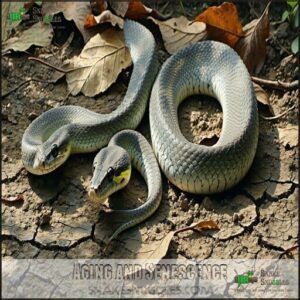This site is supported by our readers. We may earn a commission, at no cost to you, if you purchase through links.
 Snakes can live surprisingly long lives, depending on their species and environment.
Snakes can live surprisingly long lives, depending on their species and environment.
In the wild, most snakes live around 10 to 20 years, but captivity changes the game.
With proper care, including the right diet, a comfortable habitat, and regular health check-ups, many pet snakes, like ball pythons or corn snakes, can live over 30 years.
Some species, like boas, might even reach 40 years or more!
Factors like predators, habitat, and food availability often cut lifespans short in the wild, while controlled settings remove these risks.
Want your pet snake to thrive? It’s all about care, consistency, and a little curiosity!
Table Of Contents
- Key Takeaways
- Snake Lifespan Overview
- How Long Do Snakes Live
- Snake Species Longevity
- Captivity Lifespan Factors
- Wild Snake Lifespan Factors
- Snake Longevity Variation
- Pet Snake Longevity
- Snake Lifecycle Stages
- Factors Affecting Snake Longevity
- Maximizing Snake Lifespan
- Frequently Asked Questions (FAQs)
- How long do ringneck snakes live?
- How long do pet snakes live?
- How long do corn snakes live?
- How long do black snakes live?
- How long do snakes live in the wild?
- How long do venomous snakes live?
- How long do king snakes live in captivity?
- How long do wild snakes live?
- How long do most snakes live?
- Can snakes live 300 years?
- Conclusion
Key Takeaways
- Pet snakes often live 15-30 years in captive conditions, while wild snakes usually live 6-20 years depending on species and environment.
- Captive snakes thrive with proper care, including a balanced diet, stable temperatures, and regular vet check-ups.
- Species size and reproduction rates directly affect lifespan, with larger, slower-reproducing snakes generally living longer.
- Wild snakes face predators, food scarcity, and habitat loss, which significantly shorten their lifespans compared to captive conditions.
Snake Lifespan Overview
You’ll find that snakes have surprising lifespans, ranging from just 3-4 years for wild garter snakes to over 40 years for captive pythons.
Your pet snake will likely live much longer than its wild relatives, with most captive snakes enjoying 15-30 years of life when provided proper care, consistent temperatures, and regular feeding, which can lead to a long and healthy life for your pet snake.
Captive snakes thrive with consistent care, often living 15-30 years—far outliving their wild counterparts thanks to proper feeding and ideal conditions.
Average Wild Snake Lifespan
In the face of countless environmental challenges, wild snakes typically live between 6 and 15 years.
Their natural longevity is substantially shortened by predation effects, habitat dangers, and food scarcity.
Smaller species like garter snakes average just 2-4 years in the wild, while larger pythons might reach 15-20 years.
Human encroachment and climate changes further impact average snake life, as natural selection favors adaptable individuals.
Captive Snake Lifespan
Captive snakes often enjoy dramatically longer lifespans than their wild counterparts, frequently living two to three times longer with proper care.
Captive snakes thrive with proper care, often living 2-3 times longer than their wild counterparts, thanks to enriched environments and consistent health support.
Your pet snake’s longevity depends on several factors including enclosure enrichment and genetic predisposition.
Here’s what contributes to extended snake lifespan in captivity:
- Consistent veterinary advances improving health monitoring
- Protection from natural predators and harsh elements
- Regular, appropriate feeding without overfeeding risks
- Reduced handling stressors and controlled environmental conditions
Factors Affecting Lifespan
Several key factors influence a snake’s lifespan across all species.
Genetic predisposition sets the foundation, while habitat quality and prey availability directly impact survival rates.
Environmental factors like temperature and humidity affect metabolic functions, and injury impact can substantially reduce longevity.
Disease susceptibility varies by species, with proper diet and nutrition being essential for growth.
Stress management is equally important—captive snakes in low-stress environments typically outlive their wild counterparts by decades, due to proper diet.
How Long Do Snakes Live
You’ll find that snakes have surprisingly long lifespans, with most species living between 10-20 years in the wild and up to 30-40 years in captivity.
Your pet snake’s lifespan depends on its species, with ball pythons living 20-30 years, corn snakes 15-20 years, and some reticulated pythons surviving beyond 40 years with proper care.
Snake Species Lifespan
A snake’s lifespan varies dramatically between species.
Ball pythons are marathon runners in the longevity race, living up to 62 years, while corn snakes typically reach 20 years in ideal conditions.
Boa constrictors can survive 25-30 years, and kingsnakes average 15 years.
Garter snakes have shorter life expectancies of 2-10 years.
Your snake’s species is the primary factor determining its potential life expectancy.
Captivity Vs Wild Lifespan
When comparing snake lifespan between settings, the numbers are eye-opening.
Wild snakes typically live just 10-20 years due to predation impact, limited resource availability, and habitat quality concerns.
Your pet snake, however, can live substantially longer—often 30+ years! Without predators and with consistent care, captive vs wild snakes show dramatic differences.
Pet snake lifespan benefits from reduced stress levels and lower disease prevalence.
Factors Influencing Longevity
Beyond species type, numerous factors influence snake longevity.
Your snake’s lifespan depends on several biological and environmental conditions.
- Genetic predisposition determines baseline lifespan potential
- Habitat quality affects stress levels and overall health
- Reproductive strategy impacts energy expenditure
- Injury impact can shorten life expectancy substantially
- Metabolic rate influences aging processes
These snake lifespan factors vary substantially between captive and wild environments, with proper care dramatically extending potential longevity, based on the snake’s baseline lifespan potential and overall environmental conditions.
Snake Species Longevity
You’ll find remarkable differences in how long snakes live, from ball pythons reaching 30+ years to garter snakes living just 6-10 years in captivity.
Different snake species have distinct lifespans based on their size, habitat conditions, and whether they’re living in the wild or under human care, which can significantly impact their overall lifespan.
Ball Pythons Lifespan
Owning a ball python means you’re in for a long-term commitment. Your pet’s snake lifespan varies dramatically between environments.
Wild ball pythons face threats that limit them to 10-15 years, while captive longevity can reach an astonishing 62 years with proper husbandry practices.
| Environment | Average Age | Factors Affecting Longevity |
|---|---|---|
| Wild | 10-15 years | Predators, food scarcity, harsh weather |
| Captivity | 20-30 years | Diet impact, genetic factors, care quality |
| Record | 62+ years | Ideal temperature, nutrition, veterinary care |
The factors affecting longevity in captive environments include diet, genetic factors, and the quality of care. Proper husbandry practices are essential for maximizing the lifespan of a ball python in captivity.
Corn Snakes Lifespan
While Ball Pythons hold impressive longevity records, Corn Snakes also boast remarkable lifespans.
In the wild, these popular reptiles typically survive 6 to 8 years facing predators and environmental challenges.
With proper care in captivity, however, your corn snake’s longevity can stretch to an impressive 15-20 years! Captive snakes often benefit from consistent food access, leading to extended lifespans.
Their snake age depends heavily on diet impact, environmental conditions, and genetic factors that influence their overall health and survival rate.
Boa Constrictors Lifespan
Boa constrictors boast impressive longevity, with captive specimens typically living 25 to 30 years or more.
You’ll find their snake lifespan substantially longer in controlled environments compared to wild settings where they face numerous threats.
Boa constrictor snake age correlates with size, with larger specimens often achieving greater snake longevity.
Captive breeding programs have helped document how proper care extends these magnificent snakes’ lives while supporting conservation efforts of wild populations.
Garter Snakes Lifespan
While boa constrictors enjoy decades of life, garter snakes have much shorter lifespans.
In the wild, these small reptiles typically survive only 2-4 years, though some may reach 10 years with luck.
Captive garter snakes often live longer, regularly exceeding a decade with proper care.
Three factors affecting garter snake longevity:
- Diet impact (consistent feeding improves health)
- Wild threats (predators substantially reduce lifespan)
- Captive care (controlled environments extend life)
Captivity Lifespan Factors
When you keep a snake in captivity, its lifespan depends on factors like diet, habitat conditions, and health care.
Providing proper temperatures, humidity, and regular veterinary care can substantially extend its life.
Diet and Nutrition
To boost snake lifespan, focus on diet and nutrition.
High-quality prey, proper feeding frequency, and supplementation can enhance snake longevity.
Avoid overfeeding to reduce obesity risks and guarantee hydration needs are met.
A balanced snake diet supports overall health, directly impacting snake nutrition and lifespan.
Many keepers prioritize optimal snake nutrition to guarantee their pets thrive.
| Factor | Key Points |
|---|---|
| Prey Quality | High-nutrient, species-appropriate prey |
| Feeding Frequency | Depends on snake species/age |
| Supplementation | Calcium, vitamins for health |
| Obesity Risks | Avoid overfeeding, monitor weight |
| Hydration Needs | Clean water always available |
To ensure the best care for snakes, it is crucial to understand the importance of proper feeding frequency and hydration needs.
By following these guidelines and maintaining a balanced snake diet, snake owners can significantly enhance the lifespan of their pets.
Environmental Conditions
Temperature regulation and humidity control are essential for maintaining your snake’s ideal habitat stability.
A well-designed enclosure mimics natural seasonal changes, ensuring snake longevity.
Wild snake lifespan often suffers due to harsh environmental conditions, but proper enclosure design in captivity eliminates these challenges.
Maintaining consistent temperatures with a reptile habitat controller is vital.
Stable environmental conditions greatly impact snake lifespan, promoting healthy growth and overall health for your reptile companion.
Stress and Health Management
Stress can quietly shorten a snake’s lifespan.
Poor handling techniques, loud environments, or cramped enclosures lead to chronic snake stress and health conditions.
Thoughtful enclosure design minimizes this, offering hiding spots and consistent temperatures.
Disease prevention is key, too—cleanliness matters.
Pay attention to your snake’s behavior; stress reduction and a calm habitat keep snake health stable and lifespan long.
Veterinary Care
Caring for your snake’s health? Regular veterinary care can make all the difference in its lifespan.
Here’s what to focus on:
- Exotic Vets: Always choose a vet experienced with reptiles.
- Preventative Care: Regular check-ups catch issues early.
- Parasite Control: Treat mites and worms promptly.
- Emergency Treatment: Illnesses like respiratory infection need quick action.
Proper vet care guarantees long-term snake health.
Wild Snake Lifespan Factors
In the wild, a snake’s lifespan depends on factors like predators, food availability, and harsh weather.
Human activities, such as habitat destruction, also play a significant role in shortening their lives.
Predators and Prey
Predator impact plays a huge role in snake survival, cutting lifespans short.
Juvenile vulnerability is high, as many young fall prey to eagles, mongooses, or even other snakes.
Predator pressure keeps wild snakes on edge, influencing hunting strategies.
Prey availability also matters—without enough food, they can’t thrive.
The food chain heavily shapes their lifespan and survival odds.
Climate and Habitat
Wild snakes heavily rely on habitat stability and resource availability for survival.
Geographic location and climate extremes play key roles in shaping snake longevity.
Seasonal changes can reduce snake lifespan by creating food shortages or extreme weather.
To thrive, snakes need environments with balanced temperatures and steady resources that support their natural behaviors, ensuring healthier, longer lives.
- Resource availability supports survival.
- Stable habitats improve snake lifespan.
- Climate extremes harm snake longevity.
Human Encroachment
As habitats shrink due to urban expansion and pollution impact, snakes face reduced lifespans.
Habitat destruction limits food and shelter, while road mortality poses constant risks.
Conservation efforts aim to curb these losses, but human activities remain a major challenge.
| Threat | Impact on Snakes | Example | Longevity Effects |
|---|---|---|---|
| Habitat Destruction | Loss of shelter, food | Urban development | Shorter snake life expectancy |
| Urban Expansion | Displaced snake populations | Construction zones | Reduced snake longevity |
| Road Mortality | Increased deaths | Traffic fatalities | Lower snake lifespan |
| Pollution Impact | Contaminated habitats | Plastic waste, chemicals | Health risks, shortened life expectancy |
The table highlights the major threats to snake populations, including habitat destruction, urban expansion, road mortality, and pollution impact, all of which contribute to reduced lifespans.
Snake Longevity Variation
Snake lifespan varies widely, depending on factors like species, habitat, and diet. Larger species or those with slower reproduction rates often live longer than smaller, fast-reproducing ones.
Species Specific Lifespan
Snake species lifespan varies widely.
Python longevity reaches over 40 years in captivity, while garter longevity maxes around 10 years.
A Kingsnake lifespan averages 15-23 years, while Corn snake lifespan hits 20 years with care.
Boa lifespan often exceeds 30 years in captivity.
Factors like size and diet influence snake species longevity, revealing diverse lifespans across types of snakes.
Size and Reproduction
Snake size and reproduction go hand in hand with lifespan.
Larger species like boas and pythons live longer, whereas smaller, fast-breeding species mature quickly and age faster.
Sexual dimorphism plays a role too—females, focused on clutch size and reproductive rate, may outlive males in some cases.
Growth patterns and reproductive behaviors vary by snake species, influencing their overall longevity.
Egg Laying Vs Live Bearing
Snake reproduction strategies, like egg-laying and live-bearing, impact longevity and offspring survival.
Egg-laying snakes invest energy in producing many eggs, relying on warm environments for hatching.
Viviparous snakes, however, give birth to live young, which can adapt better to environmental challenges.
Some species utilize ovoviviparous reproduction, retaining eggs internally until they hatch.
Each method offers evolutionary advantages shaped by survival needs, with snake lifespan varying by species due to these breeding and environmental adaptation factors, including the impact on offspring survival and overall longevity.
Pet Snake Longevity
When cared for properly, pet snakes can live remarkably long lives, often exceeding 20 years and in some cases reaching 30 or more.
Their longevity depends on factors like diet, enclosure conditions, and regular health checks.
Proper Care and Handling
Proper snake care starts with safe handling and a well-designed enclosure.
Always support your snake’s body to reduce stress.
Keep the enclosure’s temperature and humidity levels stable for health.
Handling should be gentle to avoid fright or injury.
-
Tips for safe handling:
- Always wash hands before and after interactions.
- Avoid sudden movements.
- Limit handling during shedding.
- Make regular, calm interactions a priority.
Environmental Enrichment
A well-designed enclosure with complexity mimics natural behaviors, boosting cognitive stimulation and reducing stress.
Offer enrichment types like climbing branches, hides, or textured surfaces to promote activity.
Adding variety enhances their snake lifespan through physical and mental health.
| Enrichment Type | Benefit | Example |
|---|---|---|
| Climbing branches | Exercise and agility | Driftwood, sturdy vines |
| Hides | Security and comfort | Rocks, cork bark |
| Textured surfaces | Sensory stimulation | Pebbles, rough tiles |
Health Checks and Veterinary Care
Monitoring your snake’s health isn’t just smart—it’s lifesaving.
Preventative care like regular checkups and parasite control can catch issues early, from common ailments to serious snake diseases.
Emergency care helps during unexpected health risks, while guidance on euthanasia options guarantees compassion when needed.
Partnering with a vet experienced in snake veterinary care guarantees your pet snake thrives, reducing long-term risks.
Regular fecal analysis can help detect internal and external parasites to ensure preventative care and overall snake health.
Snake Lifecycle Stages
Snakes go through several key stages in their lifecycle, starting from eggs or live birth and continuing through growth, maturity, and aging.
Each stage is influenced by factors like species, environment, and available resources, shaping their development and overall lifespan.
Reproductive Maturity
Most snakes reach sexual maturity between 2 to 4 years, depending on species and environmental conditions.
Mating behavior varies; some retain sperm for later use.
Breeding age impacts clutch size and reproductive frequency, with females producing eggs or live young yearly or biennially.
The snake reproductive system plays a vital role in their lifespan, ensuring survival through efficient reproduction, which is crucial for their survival.
Growth and Development
Snake growth is fascinating! From hatchling survival to maturity onset, development varies by species.
Rapid growth happens in juveniles, driven by shedding frequency as they outgrow their skin. Growth rates depend on food availability and environment.
Size variation emerges early, with some reaching snake maturity at 2-4 years. Regular shedding supports snake longevity, ensuring healthy development throughout these critical stages, which is crucial for their overall growth and development.
Aging and Senescence
As snakes age, cellular senescence causes organs to decline, impacting their longevity.
Reproductive aging reduces fertility, while age-related diseases like infections or tumorous growths become common.
Lifespan limits vary by species, with larger snakes often living longer.
Factors influencing longevity include genetics, environment, and care.
Snake mortality climbs as systems weaken, emphasizing the importance of a stable habitat for extended lifespans.
Factors Affecting Snake Longevity
Regarding how long snakes live, factors like genetics, environmental conditions, and health care play a huge role.
Understanding what affects their longevity helps you provide better care and make certain they live healthy, longer lives, which is influenced by genetics.
Genetics and Inheritance
A snake’s lifespan isn’t just nature or nurture—it’s in the genes. Genetic predisposition affects longevity, with some species inheriting traits for resilience.
Mutations can shorten lifespan or introduce inherited diseases. Breeding influence plays a big role too, shaping key traits over generations.
- Some snake species naturally live longer due to genetics.
- Mutations impact health and lifespan.
- Breeding affects genetic quality.
Environmental Stressors
A degraded habitat challenges snake longevity.
Climate change disrupts their environments, making survival harder.
Food scarcity forces snakes to travel farther, increasing exposure to predators.
Pollution impacts their health, while human activity often damages snake habitats.
Environmental factors cause stress that shortens their lifespan, especially in wild settings where resources are limited and dangers are constant, leading to a significant impact on snake longevity and overall survival.
Disease and Parasites
Diseases like Inclusion Body Disease and Respiratory Infections, along with Parasitic Infestations, can dramatically impact snake longevity.
Scale Rot and Fungal Diseases often stem from poor habitat conditions, reducing snake lifespan if untreated.
Regular veterinary care and parasitology expertise are essential for prevention and treatment, and monitoring for health risks guarantees a healthier, longer life for your snake.
Protecting it from avoidable complications is crucial, and this can be achieved through proper care, making regular veterinary care a vital component of snake ownership.
Maximizing Snake Lifespan
To help your snake live a long, healthy life, focus on creating the best possible environment and meeting their specific needs.
Proper housing, a balanced diet, and regular veterinary care are essential for maximizing their lifespan, as they directly impact the snake’s overall health and well-being, making regular veterinary care crucial.
Optimal Care and Housing
A well-designed snake enclosure helps maximize lifespan. Focus on these essentials:
- Enclosure Size: Provide enough space for your snake to move comfortably.
- Temperature Gradient: Maintain warm and cool zones using heat sources and thermometers.
- Humidity Control: Use hygrometers and adjust for the species’ needs.
Selecting the right enclosure size is vital for the snake’s well-being.
Adding proper substrate choice and enrichment items keeps your snake healthy and stress-free.
Nutrition and Diet
A balanced snake diet is vital for maximizing lifespan.
Prey quality matters—offer appropriately sized, nutritious meals. Feeding frequency depends on age and species.
Young snakes eat more often than adults. Watch for obesity risks; overfeeding harms health.
Picky eaters may need persistence or supplementation. Paying attention to snake diet requirements guarantees proper nutrition, supporting health and extending their lifespan effectively.
Health Management and Veterinary Care
Keeping your snake healthy means staying proactive.
Preventative care, like regular checks for parasites or disease diagnosis, is key.
Finding a specialized vet guarantees the best care when health risks or injuries arise.
Skin infections can arise from improper environments.
Veterinary care also helps with parasite control and injury treatment if needed.
These snake care tips keep your pet thriving, giving it the long life it deserves, through proper care.
Frequently Asked Questions (FAQs)
How long do ringneck snakes live?
Ringneck snakes may live up to 10 years in the wild but often face threats like predators and habitat loss.
In captivity, with proper care, they can reach around 6 years or occasionally longer, which can be considered a complete lifespan for these animals in a controlled environment.
How long do pet snakes live?
Pet snakes often live between 10 to 20 years, but with proper care, some can exceed 30 years.
Their lifespan depends on factors like species, diet, habitat conditions, and regular veterinary care to guarantee health.
How long do corn snakes live?
Corn snakes live 6-8 years in the wild due to predators and food scarcity.
In captivity, with proper care like accurate temperature, a balanced diet, and a safe environment, they thrive for 15-20 years.
How long do black snakes live?
Black snakes, like the Eastern Rat Snake, can live around 10-15 years in the wild.
But in captivity, they might hit 20 years or more, thanks to stable care, food, and safety.
How long do snakes live in the wild?
In the wild, snakes live anywhere from 2 to 20 years depending on their species.
Predators, food shortages, and harsh weather shorten their lives, while larger, slower-reproducing species tend to survive longer in stable habitats.
How long do venomous snakes live?
Venomous snakes, like rattlesnakes or cobras, typically live 10 to 20 years, depending on species and habitat.
In captivity, with proper care, they often surpass this range, reaching up to 25 years or more.
How long do king snakes live in captivity?
Like a well-kept secret, kingsnakes thrive in captivity, living 15 to 20 years with proper care.
Provide a clean enclosure, consistent temperatures, and a healthy diet to guarantee they enjoy a long, vibrant life.
How long do wild snakes live?
Snakes in the wild usually live between 6 to 20 years, depending on their species.
They face challenges like predators, harsh weather, and limited food.
Larger species tend to live longer due to fewer natural threats.
How long do most snakes live?
To put it simply, most snakes live 10-20 years, but it varies by species and environment.
Captive snakes often outlive wild ones thanks to better care, food, and safety from predators, sometimes reaching 30 years or more.
Can snakes live 300 years?
No, snakes can’t live 300 years.
Their lifespan varies by species, with wild snakes living 10-20 years and some captive ones reaching 30-40 years.
Even the oldest documented snakes fall far short of that.
Conclusion
Did you know ball pythons can live over 30 years in captivity, while some boas exceed 40?
It’s clear that snakes thrive with attentive care. Understanding how long snakes live depends on their environment, species, and quality of care.
Controlled conditions like proper feeding, stress-free habitats, and regular veterinary check-ups are critical for maximizing their lifespan.
Whether in the wild or as a pet, snakes’ longevity reflects your effort in providing an ideal environment and consistent care.
- http://www.chicagoherp.org/bulletin/28(4).pdf?fbclid=IwAR3QFnGuJrZo4acWqnS29P5Nij-cbxdeWKaPP8d0brnyUzjO-juWDqePyUs
- https://www.sciencedirect.com/science/article/pii/S1090023316301721?via%3Dihub
- https://www.units.miamioh.edu/cryolab/publications/documents/Costanzo88_Cryo-lett.PDF
- https://www.cbsnews.com/news/python-st-louis-zoo-laid-7-eggs-without-male/
- https://www.nytimes.com/2020/09/12/us/st-louis-zoo-62-year-old-python.html




















